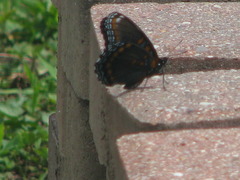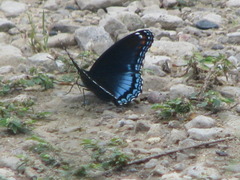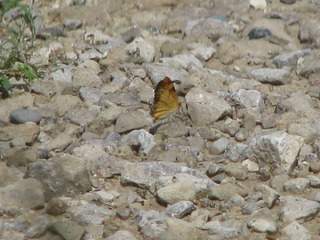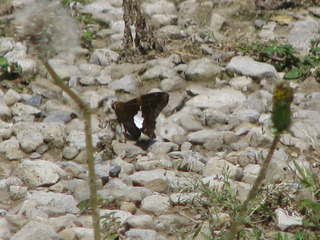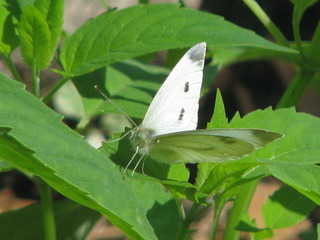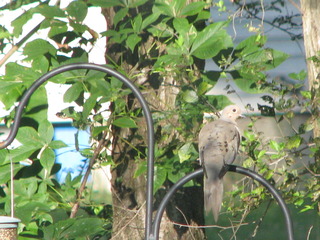
Not too long ago, Birdchick wrote about watching young birds learning to use feeders. I had the opportunity to see this, myself.
I noticed a Mourning Dove, several days running, sitting on or near the double-crook in the backyard. I saw him (her?) carefully observing other birds take seed from the feeder. He was obviously trying to figure it out.
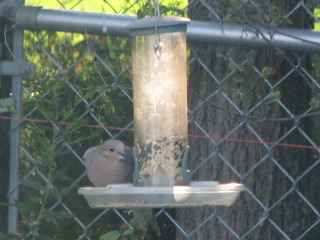 Eventually, he got the idea. Mourning Doves are big birds. You might notice 2 things in this image:
Eventually, he got the idea. Mourning Doves are big birds. You might notice 2 things in this image:
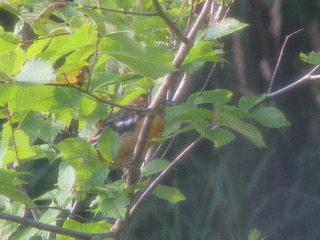 I don't know what this is. I think it's a Baltimore Oriole. I suppose it might be an Eastern Towhee. Originally, I thought Carolina Wren, but it's not. One of the reasons I suspect Oriole is the location. She's (if it's a Baltimore, it's female) in a young tree growing in the middle of the raspberry patch. At the time, that would have been the best source of fruit around.
I don't know what this is. I think it's a Baltimore Oriole. I suppose it might be an Eastern Towhee. Originally, I thought Carolina Wren, but it's not. One of the reasons I suspect Oriole is the location. She's (if it's a Baltimore, it's female) in a young tree growing in the middle of the raspberry patch. At the time, that would have been the best source of fruit around.
I heard her outside a window I'm hardly-ever at. The image quality isn't great, because I shot through a screen window.
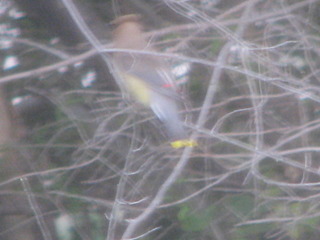 And, speaking of lousy pictures snapped through window-screen, here's another. This one has the added virtue of being both hand-held and at extreme magnification, on a fairly windy day. This a Cedar Waxwing. I include because (1) Aside from some unconscious ones that flew into the side of my parents' house, I'd never seen one, and (2) I didn't know about the red wingtips and yellow tailtip, and thought my camera was broken. (I'm not kidding. It was only when I saw a second photo showing them, that I realized they weren't artifacts.) So, new bird! Yay. (Despite the very poor image, you can tell this is a Cedar Waxwing, and not a Bohemian, by the yellow on the side of the abdomen. Bohemians don't have that.)
And, speaking of lousy pictures snapped through window-screen, here's another. This one has the added virtue of being both hand-held and at extreme magnification, on a fairly windy day. This a Cedar Waxwing. I include because (1) Aside from some unconscious ones that flew into the side of my parents' house, I'd never seen one, and (2) I didn't know about the red wingtips and yellow tailtip, and thought my camera was broken. (I'm not kidding. It was only when I saw a second photo showing them, that I realized they weren't artifacts.) So, new bird! Yay. (Despite the very poor image, you can tell this is a Cedar Waxwing, and not a Bohemian, by the yellow on the side of the abdomen. Bohemians don't have that.)
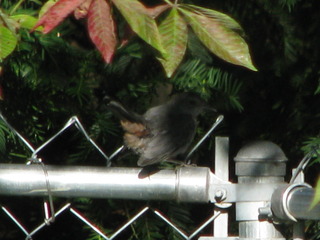
I noticed a Mourning Dove, several days running, sitting on or near the double-crook in the backyard. I saw him (her?) carefully observing other birds take seed from the feeder. He was obviously trying to figure it out.
 Eventually, he got the idea. Mourning Doves are big birds. You might notice 2 things in this image:
Eventually, he got the idea. Mourning Doves are big birds. You might notice 2 things in this image:- He's too big for the perch-pegs, and has to sit on the tray under the feeder.
- There isn't much seed left in that feeder.
 I don't know what this is. I think it's a Baltimore Oriole. I suppose it might be an Eastern Towhee. Originally, I thought Carolina Wren, but it's not. One of the reasons I suspect Oriole is the location. She's (if it's a Baltimore, it's female) in a young tree growing in the middle of the raspberry patch. At the time, that would have been the best source of fruit around.
I don't know what this is. I think it's a Baltimore Oriole. I suppose it might be an Eastern Towhee. Originally, I thought Carolina Wren, but it's not. One of the reasons I suspect Oriole is the location. She's (if it's a Baltimore, it's female) in a young tree growing in the middle of the raspberry patch. At the time, that would have been the best source of fruit around.I heard her outside a window I'm hardly-ever at. The image quality isn't great, because I shot through a screen window.
 And, speaking of lousy pictures snapped through window-screen, here's another. This one has the added virtue of being both hand-held and at extreme magnification, on a fairly windy day. This a Cedar Waxwing. I include because (1) Aside from some unconscious ones that flew into the side of my parents' house, I'd never seen one, and (2) I didn't know about the red wingtips and yellow tailtip, and thought my camera was broken. (I'm not kidding. It was only when I saw a second photo showing them, that I realized they weren't artifacts.) So, new bird! Yay. (Despite the very poor image, you can tell this is a Cedar Waxwing, and not a Bohemian, by the yellow on the side of the abdomen. Bohemians don't have that.)
And, speaking of lousy pictures snapped through window-screen, here's another. This one has the added virtue of being both hand-held and at extreme magnification, on a fairly windy day. This a Cedar Waxwing. I include because (1) Aside from some unconscious ones that flew into the side of my parents' house, I'd never seen one, and (2) I didn't know about the red wingtips and yellow tailtip, and thought my camera was broken. (I'm not kidding. It was only when I saw a second photo showing them, that I realized they weren't artifacts.) So, new bird! Yay. (Despite the very poor image, you can tell this is a Cedar Waxwing, and not a Bohemian, by the yellow on the side of the abdomen. Bohemians don't have that.)
Ever heard of being "in the Catbird seat"? There he is. I'm happy about this image. Apparently, these guys are frequently about, but very secretive. I thought I'd heard a Catbird around; they take their name from sounding like a cat meowing. It was very cool to photograph this unknown bird, then discover what I'd seen. I wish I'd gotten him a little more in the sun. But I got the russet-colored vent and the up-thrust tail. The guidebooks tell me those are both characteristic traits of Catbirds.
Nicole's hummingbird-feeder is a success. This is a female Ruby-Throated Hummingbird. If you compare her wings to her tail, you'll notice her tail isn't blurred. Sibley and Birds of Michigan both tell me this is characteristic of Ruby-Throats. They hold their tails still while hovering.
Incidentally, the dope-slap was (gently!) delivered by Nicole. I was thinking of the waxwing & oriole images when I titled this entry. This image was a late addition. I was working with it, when I heard "Poorly-Executed?!" <bop> "That's awesome!" The photograph is pretty-good. But the wife is definitely awesome.
Incidentally, the dope-slap was (gently!) delivered by Nicole. I was thinking of the waxwing & oriole images when I titled this entry. This image was a late addition. I was working with it, when I heard "Poorly-Executed?!" <bop> "That's awesome!" The photograph is pretty-good. But the wife is definitely awesome.


